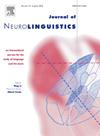Auditory P300 event-related potential and acoustic features of voice and speech in adolescents at risk for suicide: A pilot study
IF 1.2
3区 心理学
Q2 LINGUISTICS
引用次数: 0
Abstract
Suicide remains a leading cause of external mortality, posing a significant yet preventable challenge. This study explores potential associations between suicide risk and neurophysiological (Auditory P300 Event-Related Potential) and acoustic voice and speech parameters in adolescents. The study employed a cross-sectional design. Thirty secondary school students underwent auditory assessment, P300 measurement (PEATS Eclipse EP25), and acoustic analysis of voice and speech. Suicide risk was determined using the Okasha Suicidality Scale and the Beck Depression Inventory. Acoustic analysis was performed using Praat software for phonetic research, a Focusrite Scarlett interface, and a condenser microphone to assess fundamental frequency (F0), jitter, shimmer, and formants (F1, F2, F3). Data were analyzed using IBM SPSS Statistics version 26.0 and MATLAB R2022a (MathWorks Inc.) for signal processing and feature extraction, applying both descriptive and inferential statistical methods. Adolescents at risk for suicide exhibited significantly longer P300 latencies in both ears compared to their non-risk peers (p < 0.05), while no significant differences were observed in P300 amplitude. Regarding voice analysis, significant group differences were found in the F1, F2, and F3 formants during the open-ended question task (p < 0.05), suggesting alterations in speech articulation. However, vowel production parameters did not differ notably between groups. Adolescents at risk for suicide demonstrated delayed neurophysiological processing (increased P300 latency) and altered speech articulation during spontaneous speech tasks. These findings highlight the potential of integrating P300 and acoustic analysis of voice and speech as complementary markers in assessing cognitive and emotional functioning in suicide risk detection.
青少年自杀风险的听觉P300事件相关电位和声音和言语的声学特征:一项初步研究
自杀仍然是外部死亡的主要原因,构成了一个重大但可预防的挑战。本研究探讨了青少年自杀风险与神经生理(听觉P300事件相关电位)和声学语音和言语参数之间的潜在联系。该研究采用了横断面设计。对30名中学生进行了听力评估、P300测量(PEATS Eclipse EP25)以及声音和言语的声学分析。采用Okasha自杀倾向量表和Beck抑郁量表测定自杀风险。声学分析使用Praat软件进行语音研究,使用Focusrite Scarlett接口,使用电容麦克风评估基频(F0)、抖动、闪烁和共振(F1, F2, F3)。数据分析使用IBM SPSS Statistics version 26.0和MATLAB R2022a (MathWorks Inc.)进行信号处理和特征提取,采用描述性和推断性统计方法。有自杀风险的青少年双耳P300潜伏期明显长于无自杀风险的同龄人(p < 0.05),而P300振幅无显著差异。在语音分析方面,开放式问题任务中F1、F2和F3共振峰组间差异显著(p < 0.05),提示语音清晰度发生了改变。然而,元音产生参数在组间没有显著差异。有自杀风险的青少年表现出神经生理处理延迟(P300潜伏期增加)和自发言语任务中言语清晰度的改变。这些发现强调了将P300与声音和言语的声学分析结合起来作为评估自杀风险检测中的认知和情感功能的补充标记的潜力。
本文章由计算机程序翻译,如有差异,请以英文原文为准。
求助全文
约1分钟内获得全文
求助全文
来源期刊

Journal of Neurolinguistics
医学-神经科学
CiteScore
3.90
自引率
5.00%
发文量
49
审稿时长
17.2 weeks
期刊介绍:
The Journal of Neurolinguistics is an international forum for the integration of the neurosciences and language sciences. JNL provides for rapid publication of novel, peer-reviewed research into the interaction between language, communication and brain processes. The focus is on rigorous studies of an empirical or theoretical nature and which make an original contribution to our knowledge about the involvement of the nervous system in communication and its breakdowns. Contributions from neurology, communication disorders, linguistics, neuropsychology and cognitive science in general are welcome. Published articles will typically address issues relating some aspect of language or speech function to its neurological substrates with clear theoretical import. Interdisciplinary work on any aspect of the biological foundations of language and its disorders resulting from brain damage is encouraged. Studies of normal subjects, with clear reference to brain functions, are appropriate. Group-studies on well defined samples and case studies with well documented lesion or nervous system dysfunction are acceptable. The journal is open to empirical reports and review articles. Special issues on aspects of the relation between language and the structure and function of the nervous system are also welcome.
 求助内容:
求助内容: 应助结果提醒方式:
应助结果提醒方式:


